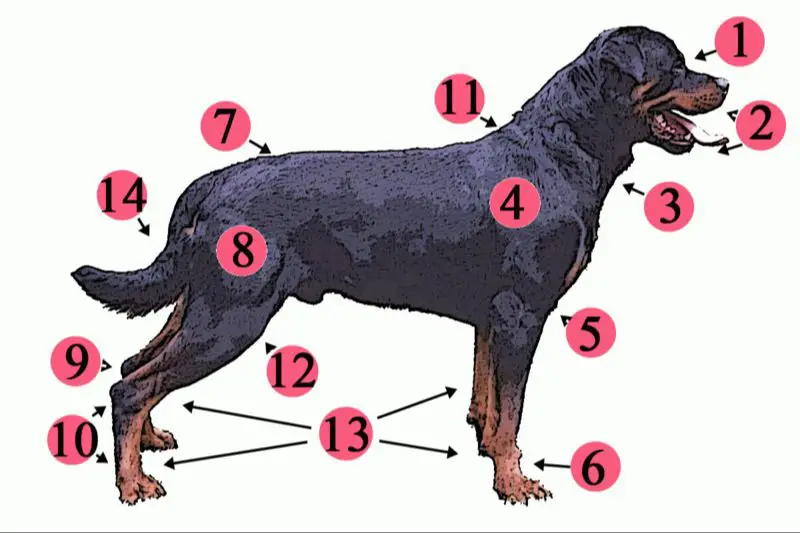Introduction
Dogs use their paws for many important functions, from walking and running to digging and sensing. Their front and back paws play somewhat different roles. This leads to an interesting question – are a dog’s front paws more sensitive than their back paws?
In this article, we will compare the anatomy and nerve structures of front and back dog paws. We’ll look at differences in mobility, scent detection, and injury rates that provide clues to sensitivity. Through observational research and experiments, we can shed light on whether front paws are indeed more sensitive. We’ll also discuss some implications for dog owners and care of our canine companions’ feet.
Anatomy of Dog Paws
Dog paws are complex structures that serve many important functions. The main parts of a dog’s paw include:
- Pads – The thick, rubbery pads on the bottom of the paw provide cushioning and traction. Dogs have 5 pads on their front paws and 4 pads on their rear paws.
- Toes – Dogs have 4 toes on each of their front paws and 5 toes on each rear paw. Their dewclaw is located higher up on the leg. Each toe has a nail and digital pad.
- Claws – Also called nails, claws help dogs grip surfaces and dig. They’re made of keratin like human fingernails.
- Metacarpal pads – There is one metacarpal pad at the back of each front paw above the toes.
- Carpus – The carpus is equivalent to the human wrist. It provides flexibility and mobility to the paw.
The bottom of a dog’s paws has thick fat padding to absorb shock. Smaller tissues connect the various bones, ligaments, and tendons that allow the paw to move in different directions.
Nerve Endings in Front vs Back Paws
Dogs have a high concentration of nerve endings in their paws compared to other areas of their bodies. However, studies have shown that their front paws generally contain more nerve endings than their back paws.
The front paws have a larger number of sensory receptors in the pads. These include specialized nerve endings called mechanoreceptors that sense touch, pressure and texture. There are also thermoreceptors that detect temperature, and nociceptors for sensing pain. This dense network of nerves allows dogs to have a high degree of sensitivity and dexterity in their front paws.

In contrast, the pads on the back paws have fewer mechanoreceptors and nociceptors. The nerves are more dispersed compared to the front paws. This suggests dogs rely more on their front paws for touch perception and object manipulation. The back paws are more specialized for propulsion, balance and stability while walking or running.
Beyond the paw pads, the front limbs also contain more nerve endings in the joints, muscles and skin. This includes proprioceptive nerves that provide positional and motion feedback. Overall, the front legs have a richer nerve supply optimized for sensory discrimination and motor control.
Observing Dog Behavior
One way to gather evidence about whether a dog’s front paws are more sensitive than their back paws is by carefully observing their behavior. There are several common dog behaviors that may indicate greater sensitivity in their front paws.
Licking or chewing at the front paws frequently can signify discomfort, pain, or irritation, which may be caused by enhanced sensitivity. Dogs may also hesitate to step on or touch certain surfaces with their front paws, while being willing to walk on those same surfaces with their back paws. This selective avoidance suggests the front paws are more sensitive.
Dogs may also lift their front paws often when standing or walking, touching down only briefly with their toes. Quickly retracting their front paws could demonstrate discomfort from excessive sensitivity. Similarly, dogs may distribute more of their weight rearward and avoid bearing weight on their front legs and paws.
Paying attention to subtle behaviors like paw licking, paw lifting, and hesitancy to touch surfaces provides clues about your dog’s comfort levels and relative sensitivity in their front versus hind paws. The more observational evidence along these lines, the stronger the case for greater front paw sensitivity.
Mobility Differences
While all four paws allow dogs to move and run, the front and back pairs serve different functions when it comes to mobility. The front legs and paws are used for more detailed, dexterous movements. Dogs rely on their front legs for actions like digging, scratching, reaching, and grabbing objects. The front paws can turn and pivot to allow dogs to maneuver in tight spaces. Dogs also use their front legs when eating and drinking, to hold bowls and bones.
In contrast, dogs primarily use their back legs to provide power and forward propulsion when walking and running. The back legs bear most of the body weight and generate the force needed to jump and sprint. While the back paws do participate in stability, balance, and turning, their main role is to drive the dog forward. So the front legs handle fine motor control, while the back legs supply raw power and strength.
This mobility difference arises from the physiology and skeletal structure of dogs. Their front legs are attached to the chest rather than hips, providing greater range of motion. The shoulders and wrists in the front legs contain multiple joints for flexibility. In the hind legs, the hips and knees are built for stability and force generation. So the front and back pairs adapted for specialized roles due to how dogs evolved to walk, run, and utilize their paws.
Scent Receptors
Dogs have scent glands located in the paw pads on their feet. These glands release pheromones and other scents that allow dogs to mark their territory when walking or running. The scent glands are especially concentrated on the front paws.

The paw pads on the front feet have up to three times as many scent glands as the rear paws. This allows dogs to leave more concentrated scents as they move forward, marking their path and alerting other dogs in the area.
When a dog scratches or digs at the ground after eliminating, it is in part to spread the scent from these paw glands. By distributing their scent, dogs can better mark their territory and convey information to other dogs in the area.
The higher concentration of scent glands on the front paws compared to rear paws suggests that the front paws are more sensitive. The abundance of scent receptors gives the front paws a key sensory role for dogs as they move through and interact with their environment.
Sensitivity Testing
Dog paws are equipped with mechanoreceptors to sense pressure and textures, as well as thermoreceptors for temperature sensitivity. While research on the sensitivity of dog paws is limited, there are some studies that have attempted to measure and compare the touch sensitivity on front versus back paws.
One study from Belgium published in Veterinary Dermatology used mechanical quantitative sensory diagnostic testing on 10 healthy dogs. They applied different filament forces and recorded response rates on various parts of the dogs’ bodies, including the front and hind paw pads. The study found that front paws required significantly less force (around 0.07 grams) to elicit a response compared to hind paws (around 1 gram). This suggests front paws have greater sensitivity and touch discrimination.

Another study published in Physiology & Behavior tested the withdrawal response thresholds in dogs’ paw pads. They used Semmes-Weinstein monofilaments that exert calibrated forces to see which strengths caused dogs to withdraw their paws. They found that front paw pads were 2-4 times more sensitive than hind paws. The front paws reacted to lighter forces around 8 grams, while back paws needed forces of 16-32 grams to elicit a response.
While limited, these studies demonstrate quantitatively that a dog’s front paws and pads seem to have more touch sensitivity compared to their back paws. The higher innervation and nerve supply to front limbs likely contributes to this difference. More research is still needed to fully understand the sensitivities of different paw regions in dogs.
Paw Injuries
Due to the higher concentration of nerve endings, front paw injuries can be more painful and debilitating for dogs than back paw injuries. Front legs bear most of the dog’s weight and are crucial for mobility and functioning.
Injuries to the front paws like cuts, burns, torn nails or pads, sprains, fractures, and abrasions can cause more pain and dramatically reduce a dog’s ability to walk, run, climb, and play. These injuries often require more intensive treatment like bandaging, splints, surgery, or rehabilitation.
Dogs naturally rely on their front legs more for movement and stability. Injuries here can significantly impact their gait and ability to bear weight. Pressure on injured front paws causes more discomfort so dogs shift their weight back. This loss of function in the front limbs strains the back legs and spine.
In contrast, back leg injuries are less debilitating overall. While still painful, dogs can adapt better to injuries on their rear paws. They rely less on their back legs for mobility and weight distribution. With treatment and rest, dogs can still walk fairly normally despite back leg or paw injuries.
So while all paw injuries require veterinary attention and care, front paw injuries can be more urgent to treat in order to restore normal functioning and mobility in dogs. Proper treatment helps minimize pain and prevent compensatory injuries in other legs from an uneven gait.
Paw Care
Caring for your dog’s paws is important to help preserve their sensitivity and keep them healthy. Here are some tips for paw care:
Regularly Inspect and Clean Paws

Check your dog’s paws regularly for any cuts, cracks, thorns, inflammation or other problems. Gently wash their paws with dog shampoo or wipes to remove dirt, salt, chemicals or other irritants.
Moisturize Paws
Use a dog-safe paw balm or moisturizer to keep your dog’s paws supple and prevent cracking. Focus on the pads and areas between the toes.
Trim Excess Fur
Long hair between toes can trap debris and moisture. Carefully trim excess fur growing on the undersides and between your dog’s paws.
Protect Paws in Extreme Heat or Cold
Use dog shoes or paw wax to protect your dog’s paws from hot pavement or snow/ice. This helps prevent burns or ice buildup.
Avoid Rough Surfaces
Walk your dog on grass instead of concrete or gravel when possible. Hard, abrasive surfaces can damage sensitive paw pads.
See a Vet for Injuries
If your dog injures a paw or you notice signs of infection, see your veterinarian. They can provide medications or treatment to help heal wounds and prevent complications.
Conclusion
After reviewing the anatomy, nerve endings, and behaviors related to dog paws, the evidence indicates that yes, dogs’ front paws are generally more sensitive than their back paws. The front paws have more nerve endings connecting them to the brain, enabling finer sensations in their paw pads and toes. Dogs also exhibit more cautious and investigative behaviors with their front paws, suggesting greater sensitivity. The mobility differences, with front paws more adapted for fine manipulation while back paws provide power, also point to the front paws detecting more nuanced stimuli. While the paws work together, the anatomy and behavior of dogs shows their front paws are the more sensitive pair.
By understanding this sensitivity difference, dog owners can provide proper care for their dog’s paws. Be especially gentle with front paws and watch for signs of injury or discomfort. Overall, a dog’s paws are a sensitive part of its body, with the front paws gathering the most sensory information about the world around them. Respecting this can lead to better paw health and avoid causing dogs undue distress on their sensitive feet.